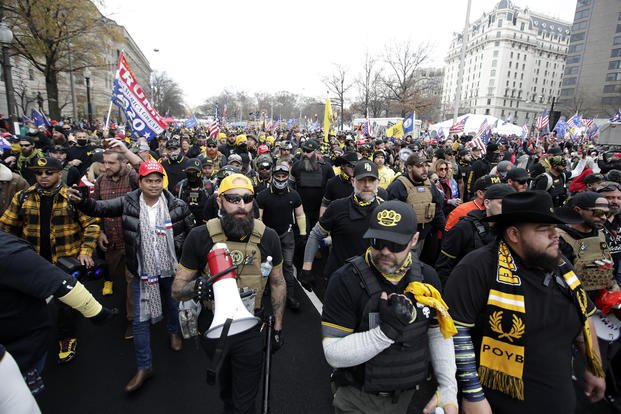Fifty years ago, far-left movements posed the biggest domestic terrorism threat to the United States, with some environmental, communist and animal rights groups taking credit for bombings, arson and vandalism at businesses and federal buildings across the country.
But terrorism carried out by right-wing actors eclipsed that of leftist movements in the 1990s, and then, the country's focus shifted to foreign terrorist organizations for more than a decade after the Sept. 11, 2001, attacks. Now, government agencies and scholars across the political spectrum agree that far-right movements have caused most of the political violence in the U.S. over the past few years – and present the most dangerous threat today. Data shows that the involvement of veterans and service members in some of these groups is helping to further the violence.
"It used to be far-left terrorism, then for a while the biggest threats were Islamist and international forms of terrorism," said Cynthia Miller-Idriss, who runs the Polarization and Extremism Research and Innovation Lab at American University. "Now, the official government assessment, universally, is that anti-government and supremacist forms of extremism are the biggest threat and the most lethal and pressing threat to the homeland."
The idea that far-right extremism poses a threat to the country has been contested by political pundits and some Republican lawmakers, who have attempted to minimize far-right violence and argued that far-left ideologies should receive more focus from law enforcement. But to even compare far-right and far-left movements in the U.S. today is a false equivalency because of the rate at which far-right violence outpaces the far left, said Miller-Idriss – analysis seconded by Liz Yates, a researcher at the immigration advocacy organization Human Rights First.
Thomas Spoehr, a scholar with the conservative Heritage Foundation who's argued against "wokeness" in the military, agreed that right-wing extremism is more prevalent than other ideologies, though he believes the issue of extremism overall is taking up too many government resources.
The numbers are hard to argue with. Right-wing ideologies were behind a majority of the nearly 600 domestic terror attacks that occurred from 2010 through 2021, according to data shared with Military Times by the Center for Strategic and International Studies, a think tank based in Washington, D.C. During that period, right-wing extremists were charged with 353 plots or attacks that caused 147 deaths, the data show. In the same time frame, far-left extremists carried out 126 plots or attacks, killing 23 people. The rest of the political violence during those years was committed by jihadist groups and ethnonationalists, which included antisemitic and Jewish extremists and Cuban exiles, among others.
The think tank's data supports findings from the Department of Homeland Security, which also determined that white supremacy was behind more domestic terrorist attacks and plots than any other ideology from 2010 through 2021.
Neither left nor right, just violent
While DHS acknowledged white supremacy was behind much of the violence of the last several years, the agency – and the rest of the executive branch – is attempting to stay out of the feud about whether extremism is a far-left or far-right issue. Rather than label instances of domestic terrorism as motivated by the "right" or "left," the FBI and DHS created four categories for extremism: racially or ethnically motivated violent extremism, anti-government or anti-authority violent extremism, animal rights or environmental violent extremism and abortion-related violent extremism.
A senior official in President Joe Biden's administration, speaking on the condition of anonymity under rules set by the White House, said the categories showed that the government is focusing its efforts where there's violence, rather than targeting one ideology over another.
"So much has become politicized that it was really important to us to make clear that this work is public safety, it's democracy protection and it does not have political angles to it," the official said. "What's fundamentally unacceptable is taking your grievance or your view on the political or ideological spectrum and turning violent with it. That is the thing that's unacceptable, whatever the underlying view might be, whether it's left, right or center."
Racially or ethnically motivated violent extremism is the "single greatest terrorism-related concern we have in the homeland right now," said a senior DHS official, also speaking on the condition of anonymity in order to describe the sensitive policy. Within that population, the people of most concern are those driven by their beliefs about the superiority of the white race, the official said. According to a DHS assessment of terrorism released in June, white supremacists pose the "most consistent threat" of violence against religious, cultural and government targets.
Others who fall into the category of racially or ethnically motivated violent extremism include those motivated by perceptions of racial injustice in America, such as groups advocating for a separate Black homeland – a motivation that doesn't fit neatly into the left or right political paradigm. And while Black separatist groups make threats of violence against the government, they carried out "minimal observed acts of violence" last year, the DHS assessment states.
Left or right labels simply don't apply to violent actors like incels, and they're not helpful in describing the Boogaloo movement, which draws anti-government extremists of all political stripes, a senior DHS official said. And no matter what the violent ideology or lack thereof, the government's prevention efforts are the same, the official said.
"Our desire is to treat it in an agnostic way is not just because of the politics – because the politics are very difficult in this space – but also because most of the preventative work that you want to do looks the same regardless of what ideology or motivating factors are driving an individual to carry out these attacks," the DHS official said.

Military-veteran nexus
Data shows the most violent groups are those on the right, especially those with members who've had military training.
Veterans' and service members' participation in right-wing violence is made clear in data from the U.S. for the National Consortium for the Study of Terrorism and Responses to Terrorism, known as START. DHS officials told Military Times that START has compiled the "best open-source data in the country" regarding the involvement of military personnel in domestic terrorism.
According to the data, 26 veterans and service members since 1990 were driven by their far-left beliefs to commit both violent and nonviolent crimes, while 333 veterans and service members were driven by their far-right beliefs to do the same. Among the violent crimes, 71% were committed by people aligned with far-right movements, while 6% were aligned with the far-left. The rest didn't fall squarely into either ideology.
Those cases don't include veterans and service members charged with crimes tied to their participation in the Jan. 6, 2021, attack on the U.S. Capitol, when myths about voter fraud in the 2020 presidential election drove supporters of former President Donald Trump to try to stop Congress from certifying the results. According to George Washington University's Program on Extremism, 131 people charged in the riot that day had served in the military.
"These are small, small numbers compared to the size of our military, but there is an increase at the moment, which is concerning," a senior DHS official said of veterans and service members involved in ideological extremism. "Racially- and ethnically- motivated violent extremism is the most frequent bias in this community, followed by anti-government extremism. That's a really dangerous cocktail for active-duty military, veterans and reservists. It's horrible for good order and discipline and horrible for combat effectiveness, given how diverse our military actually is – and scary if anti-government extremism is among the top of those categories."
Extremism experts and government officials agree that only a small number of service members and veterans participate in extremist activities. However, data shows that when they do get involved, it's often as part of far-right movements – and they tend to wield outsized influence. Veterans and service members were responsible for 25% of all extremist-driven mass fatality plots and attacks from 1990 through 2022, a START analysis found.
The Prosecution Project, a research organization that's fiscally sponsored by the Peace and Justice Studies Association at Georgetown University, issued similar findings to START's. In data shared with Military Times, the organization found 300 cases of extremist-driven crimes committed by veterans and service members since 1990. Of those, 66% were committed by far-right actors, while 2% were carried out in the name of far-left ideologies. Many of the crimes driven by right-wing actors were designed to injure, kill or intimidate a particular group of people, said Michael Loadenthal, the founder and executive director of the Prosecution Project.
"Generally speaking, and as informed by the analysis of the Prosecution Project's data covering thousands of cases, leftist violence is exceedingly rare in the past several decades and very rarely involves veterans or active duty military," Loadenthal said.
One reason for the discrepancy is the far right's efforts to recruit veterans and service members to their cause, said Josh Lipowsky, a researcher with the Counter Extremism Project who authored a report last year about far-left extremism. Lipowsky determined that today's far-left groups lack the organizational structure used by the far right.
The Patriot Front, a white nationalist and neo-fascist hate group, takes applications from prospective members, many of whom claim to have ties to the military. Far-left movements tend to comprise more broad ideological positions rather than forming into specific groups with such bureaucratic entrance procedures, Lipowsky said.
"There isn't much overt recruitment of military personnel, whereas on the far right, we see several of these violent groups specifically going after military personnel for their experience and weapons know-how," Lipowsky said. "There are individual Antifa groups, but they're not openly plastering or flyering like we see from the Patriot Front and other groups."
While small numbers of veterans and service members are involved in domestic terrorism, DHS is encouraging others in the military community to be part of the solution. DHS' prevention plan includes enlisting veterans to intervene with their peers to turn away from violence. Veterans have "an incredible reservoir of all the right stuff we can be using... to help the country address these issues," a senior DHS official said.
"Veterans contribute to civil society at a higher rate than most Americans. They run for office, they participate in local school boards," the official said. "We need to build on those strengths in order to crowd out vulnerabilities to these kinds of threats on the margin."

Violence on the left
Despite the far right causing much of the political violence over the past several years, experts aren't disregarding the left – and they shouldn't be, Yates said.
The Prosecution Project, which tracks felony-level criminal cases of domestic terrorism, maintains a database of crimes that occurred during police brutality protests following the murder of George Floyd in Minneapolis in the summer of 2020. Among the overall population, more than 300 people were charged with federal crimes as a result of the protests. Thirty-five people were charged with assaulting police officers, and the majority of charges were related to arson, civil disorder and destruction of property – a theme that Loadenthal, Lipowsky and Miller-Idriss said differentiates far-left extremism from the radical right.
Leftist movements have focused in recent years on symbolic property damage to get their messages across, Loadenthal said. Lipowsky and Miller-Idriss agreed, contending that far-right groups more often target people, rather than property.
"We are seeing spikes in far-left violence, but not to the magnitude that we're seeing on the far right, and not anywhere near the lethality that we're seeing on the far right," Miller-Idriss said. "It's mostly property damage. I think it's important to acknowledge that arson and property damage matters, but it's not the same thing as a terrorist attack on a synagogue or on a Black community in terms of the fear and death caused."
While not as lethal, Miller-Idriss warned against ignoring far-left movements. The government didn't pay enough attention to the threat of far-right terrorism before 2017, resulting in far-right groups carrying out some of their violent plots successfully, she contended. Miller-Idriss is predicting a rise in violence among environmental activists. While environmental groups aren't targeting people with violence at this point in time, violent fringe groups are likely to develop as the effects of climate change become more volatile, she said.
There are a host of other political issues that could inspire far-left actors to commit violence, said Tom O'Connor, a retired FBI special agent who investigated domestic and international extremism for more than 20 years. One group O'Connor is watching is Jane's Revenge, a militant pro-abortion rights group that emerged in 2022 following the U.S. Supreme Court's decision to overturn Roe v. Wade and end the constitutional right to abortion. The group was linked to multiple instances of vandalism at crisis pregnancy centers, which are established by anti-abortion groups to discourage pregnant women from having abortions. Jane's Revenge claimed credit last year for setting fire to one such center in Madison, Wisc. The building was empty at the time.
Since retiring from the FBI in 2019, O'Connor has continued to track instances of political violence across the country. The source of domestic terrorism in the U.S. has shifted from one ideology to the next over the past 50 years, and it's likely to change again, he said.
"I'm always looking for left-wing violent actions that are legitimately acts of violence for political means. It hasn't really been happening," O'Connor said. "I think there's a reason for that. It does not mean the groups that caused violence in 2020 have gone away. I honestly think they're just letting the right do their work for them. That's generally the yin and yang of how things have worked over the past several decades."
GOP pushback
Lawmakers don't agree about the magnitude of domestic terrorism threats in the United States. Shortly after a white supremacist killed 10 Black people at a Buffalo, N.Y., supermarket in 2022, Senate Republicans voted down a bill that would've ordered DHS, the FBI and the Department of Justice to set up offices inside their agencies focused specifically on the issue. The offices would've been tasked with issuing a report every six months about threats by white supremacists and neo-Nazis, including any instances of these ideologies infiltrating law enforcement agencies and the military. Republicans argued that the measure unfairly maligned police and service members.
The issue of extremism in the military has been fiercely fought on Capitol Hill and is shaping up to be a point of contention during the 2024 presidential race. In July, the House passed the annual defense authorization bill, which contained measures authored by Republicans that took a hard-right tack on numerous hot-button, culture-war issues, including one to eliminate a working group established to counter extremism in the ranks. Both chambers approved their versions of the defense policy bill this summer, and a conference committee is expected to convene to reconcile the differences.
Some Republicans have voiced outrage that focusing on extremism in the armed forces serves only to tarnish the military's reputation – a belief shared by Spoehr, who leads the Heritage Foundation's Center for National Defense and is a retired Army lieutenant general. Spoehr pointed to a recent survey by Rand Corporation that found no evidence that veterans harbor more extreme beliefs than the rest of the American public. Though the survey's authors have acknowledged its constraints – including that results were limited by how many people were willing to be honest in answering the questionnaire about their extremist stances – the findings have been upheld by Republicans as justification to end the Pentagon's extremism prevention efforts.
Spoehr also noted a Pentagon finding that only about 100 service members had participated in prohibited extremist activity in 2021, a small fraction of the overall force.
"I think there has been too much concern, too many resources and too much time spent on this given what we have found out about the incidents of extremism in the military," Spoehr said.
Spoehr also contends that when extremism prevention training does happen, the Pentagon should place some emphasis on far-left ideologies, such as the anti-fascist movement Antifa. In anti-extremism training materials made public by the Defense Department in 2021, the agency highlights white supremacist, neo-Nazi and anti-government sentiments as examples of extremist ideologies but doesn't cite any radical left ideologies by name.
O'Connor argued that the government doesn't go after one ideology over another, but rather focuses its attention on the sources of violence.
"The FBI doesn't look at ideologies. It's not, 'Hey, let's look at Antifa, or let's look at the Proud Boys,' because it's not illegal to be a follower of any of those groups," O'Connor said. "It's the violence – the violence dictates where the investigation goes. If there's no violence or no criminal activity, there's no investigation. And it doesn't take a rocket scientist to see that the violence over the last four years has been the most serious from the right-wing."
There's one factor the far right has now that the far left lacks – a lot of people with large followings who are "fueling the fires" for potential violence, O'Connor said. Florida Gov. Ron DeSantis, a Republican and Navy veteran, has used violent imagery so far in his 2024 presidential campaign. DeSantis said earlier this month that if elected, he'd "start slitting throats" of federal workers who he deemed part of the "deep state," which he alleges is a group of government workers trying to prevent the implementation of right-wing initiatives.
Yates, who joined Human Rights First last year after researching extremism in the military at START, agreed that far-right ideologies are being espoused by public figures more often than far-left ideas.
"The far right is more integrated into political institutions," Yates said. "There was an attempted coup on our democracy, and there have been various anti-democratic appeals and continuing disinformation campaigns coming from the far right. If we aren't acknowledging that and challenging it, then we're putting our democracy at risk."
This story originally appeared on Military Times as part of partnership with Military Veterans in Journalism












